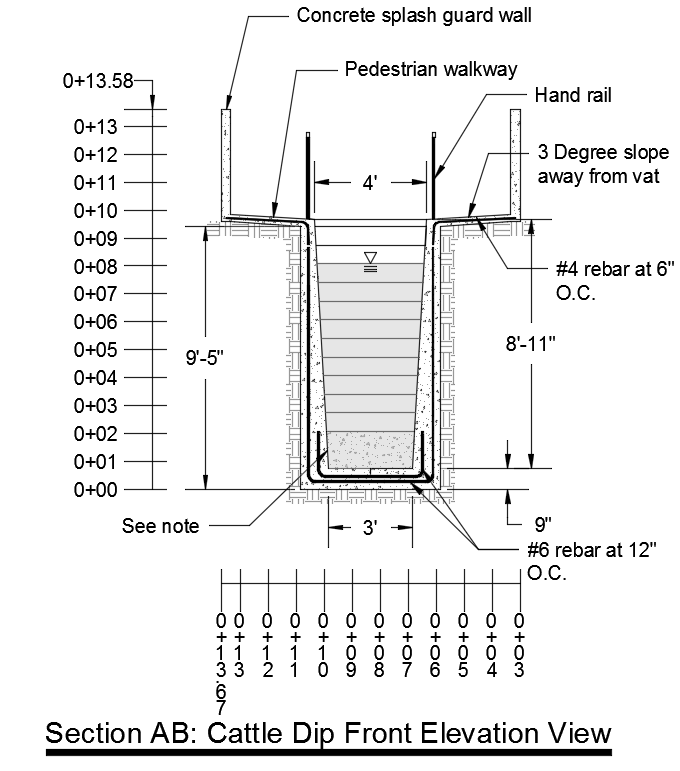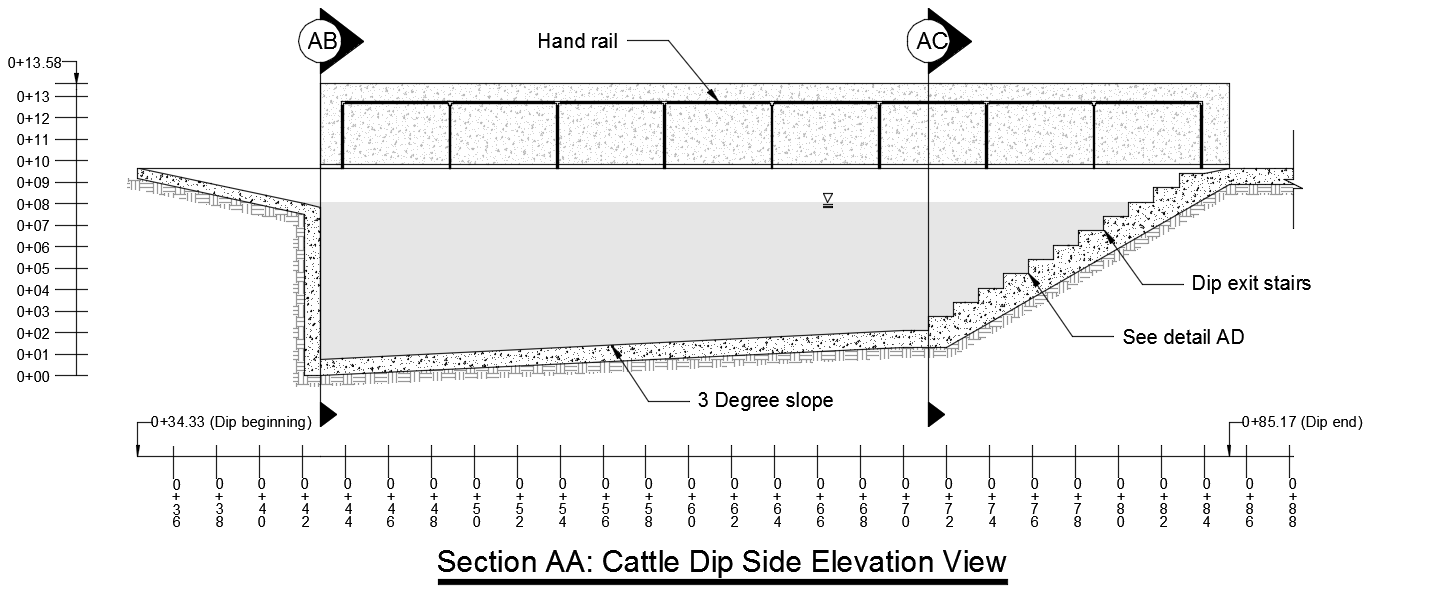Design Solutions
The top three design solutions the team compiled and researched this semester include a cattle dip, an herbal solution, and pills/vaccines.
Cattle Dip
Since a cattle dip was specifically asked for from the village, research and design of a cattle dip was the team’s primary focus this semester. The cattle dip will consist of two main design elements: The chemicals that will kill all disease carrying vectors on the cattle, and a structure that will house the chemicals. A successful cattle dip should not be so costly that it cannot be funded, it should be durable such that it will have a lifespan of several decades, it should be simple to maintain such that the villagers can ensure proper maintenance without the use of a complicated manual, and the cattle dip should be built such that no harmful chemicals will leach into the soil and cause health problems for the villagers or their livestock.
CAD Drawings:
Cross Section of the Dipping Vat

This cross section of the dipping vat is the resultant design that the team decided to use after researching a number of different types of cattle dips. The tapered walls inside the dipping vat are designed for greater support at the base, where the structure will undergo the highest pressures. The dip itself will span 44 feet, which ensures adequate exposure to the chemicals. Hand rails are provided on each side of the vat for added safety measure when maintaining the dip. At the exit of the vat, there will be a staircase for the cattle to easily climb out.
Detail Cross Section of Roof

The roof will be made out of wooden posts that support wooden trusses, capped with a corrugated metal roof.
Profile View

The cattle will enter the vat on the right side, swim to the other end, and then exit the vat by using the staircase.
Herbal Solution
Farmers are starting to investigate new methods that involve using herbal remedies to kill off ticks. The main species of tick in Tanzania is the Boophalus Micoplus tick. The main disease that the Boophalus tick carries is babesiosis, which gives the cattle flu-like symptoms. One plant that has been tested to directly treat babesiosis is the Rhoicissus Triendta (Wild Grape) plant of South Africa [1]. This plant was found to have an effect on animals already carrying the babesiosis parasite. It did prove to work, but this plant treats an infected cattle after it becomes ill. If herbal remedies are to be the solution to the Cattle Dip Team's problem, it needs to start by killing the source: the tick.

There have been a number of plants that have been researched to try to find a solution that can successfully remove ticks from cattle populations. The first plant is the Melinis Minutiflora extract. This plant had an up to 90% reduction in tick population on cattle that were tested when being used against the Boophalus tick larve [2]. This plant unfortunately left an odor on cattle meat that was used for human consumption. The next plant used was a CHCL3 extract of the Melia Azdarach plant. This had up to a 99% success rate on larve and female ticks [3]. Unfortunately, this is using an extract, which may not be readily available to the Maasai tribe. There are a number of plants whose leaves can be used without any extraction in order to kill ticks. The African Pyrethrum Flower and Wawera flowers had high success rates for the reduction of ticks on the cattle that they were tested on. Preparation of these chemicals is a pretty simple process. 250 grams of their leaves were combined with 10 liters of warm water, and then left in a dark room for twelve hours. After the twelve hours, the solution was put through a strainer to get out any large leaf particles, and then poured into a spray pack to be applied to the livestock [4]. With these tests, the Wawera plant had an 88% reduction in ticks, while the pyrethrum flowers had an 83% reduction. The studies performed suggest that there are more tests necessary to be sure if these herbs these are good solutions, as some of them can be toxic to the livestock. One more plant that was researched was the Lippia Javanica. This was a plant researched by the University of Zimbabwe as well as the University of Greenwich. This plant's leaves are also soaked for a period of time, and then turned into a spray, and showed to be affective. This plant is also easily grown and harvested [5].
Pills/Vaccines
While tick vaccines are not yet used in the United States, Australia makes use of chilled trivalent (or 3 germ) vaccine called Combavac 3 in 1. The vaccine protects cattle from Babesia bovis, Babesia bigemina and Anaplasma marginale. These are common diseases that a tick carries and may infect a cattle with. The vaccine costs $4.48 AUD per dose plus the associated shipping costs. The vaccine must be kept at 2-8°C and is supplied in two components: the frozen vaccine concentrate, which contains the three vaccine ingredients (B. bovis, B. bigemina and A. centrale), and a diluent which is used to prepare the vaccine and provided in multi-dose plastic packs. Administering the vaccine requires the use of a vaccinator gun and then administered subcutaneously (under the skin) or intramuscularly (into the muscle). The vaccine takes three to four weeks before the cattle acquire immunity to both species of Babesia and eight weeks for Anaplasma. Cattle are still at risk of developing tick fever if exposed to ticks before the vaccine immunity has taken effect. This is only of concern in animals older than nine months of age.